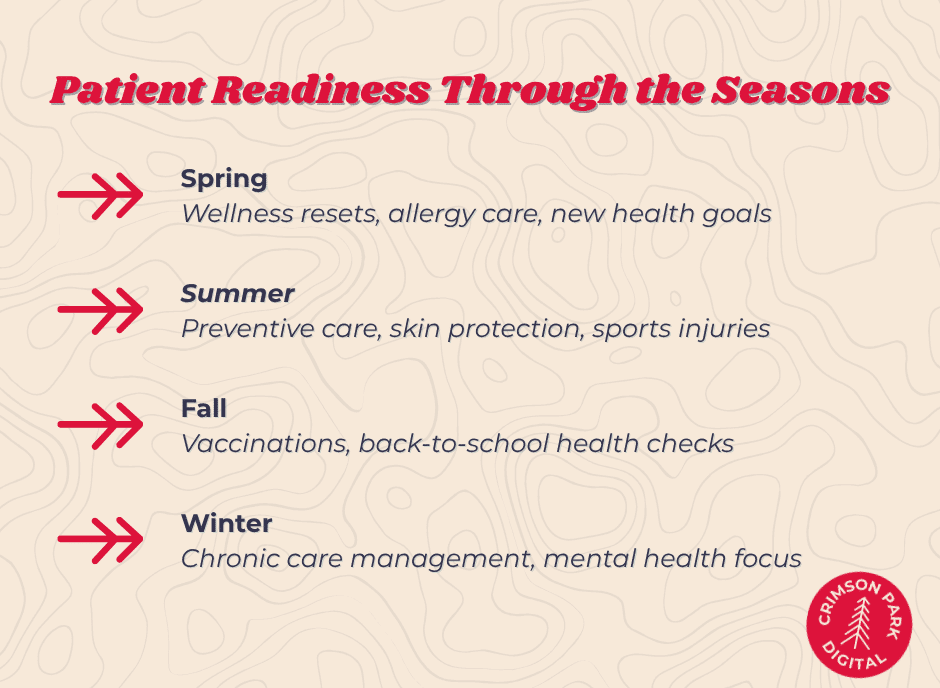The truth is, patients aren’t always ready for care. Life gets busy. Health priorities get pushed aside. But there are certain times in the year, and certain moments in a person’s life, when they’re far more open to engaging with their health. And that’s when your marketing needs to show up. Let’s break down how patient readiness works, why seasons play such a big role, and how you can start thinking about smarter, more strategic outreach.

What Is Patient Readiness, Anyway?
Picture this: one person is focused on improving their health and actively seeking options. Another hasn’t even thought about making a doctor’s appointment in over a year. That’s patient readiness in action; everyone’s on their own timeline. At its core, patient readiness is about whether someone is willing, able, and motivated to take steps toward better health. And that changes over time. If you’ve ever heard of the Transtheoretical Model of Change, you know it breaks this down into simple stages:
- Precontemplation: Health isn’t even on the radar yet.
- Contemplation: Hmm… maybe I should do something.
- Preparation: Okay, time to plan!
- Action: Let’s go—I’m doing it.
- Maintenance: Keeping up those healthy habits.
The golden rule? You don’t talk to someone who’s just starting to think about change the same way you talk to someone who’s already booking their appointment. The messaging has to match the mindset.
Timing Really Is Everything
Now, let’s talk about how the seasons play into this. Because while readiness is personal, external factors, like the time of year, can definitely tip the scales.
Ever notice how Spring makes people want to hit the reset button on their health? It’s that fresh-start energy. Wellness checks, allergy care, fitness goals; this is when people are motivated to act.
Summer is prime time for preventive care. Sun safety, hydration, sports physicals, it’s all about helping patients stay active and healthy during those busy, outdoor months.
Fall brings back-to-school energy, flu season reminders, and a focus on getting back into routines. It’s the perfect time to promote health screenings.
Winter often highlights chronic condition management and mental health. Cold weather can trigger health concerns, and the holiday season can add stress, so people are more receptive to support.
When you align your marketing with these seasonal shifts, you meet patients where they already are mentally, emotionally, and practically. That’s where real engagement happens.
Data Should Be Your Secret Weapon
Sure, you can guess when patients are ready. Or, you can let data do the heavy lifting. The beauty of digital marketing today is that you don’t have to rely on hunches. There’s a ton of insight right at your fingertips. Think about:
- Website traffic patterns: Are more people visiting your site during certain times of the year? What pages are they looking at?
- Search trends: Are patients Googling “orthopedic specialists near me” in October or in January? Are wellness check queries spiking in the spring?
- Social media activity: What healthcare topics are getting traction right now?
By watching these patterns, you can time your outreach so it lands at the perfect moment. Of course, pulling this off takes the right tools, strategy, and time; which is where a smart digital marketing agency comes in.
Personalization: The Key to Winning Attention
Nobody wants cookie-cutter health advice. People want to feel seen. The more your marketing speaks directly to their current needs and concerns, the more likely they are to engage.

That’s where personalization comes in. And no, it’s not just about slapping someone’s name on an email subject line. It’s about delivering the right message, at the right time, in the right way. Imagine this:
- A spring newsletter packed with allergy tips and wellness check reminders.
- A summer social campaign on sun safety and hydration hacks.
- A fall blog post on keeping kids healthy during back-to-school season.
- A winter ad promoting chronic care management and stress-busting services.
When patients see content that matches what’s on their mind, you earn their attention and their trust.
But Wait, What About Barriers?
Here’s the catch: even when patients are ready, barriers can get in the way. Maybe they’re worried about cost. Maybe they don’t have time. Maybe they’re overwhelmed and don’t know where to start. That’s where thoughtful marketing helps. Clear, supportive messaging can ease concerns. Making the next step simple (like online scheduling, easy payment options, or offering telehealth) removes friction. And guess what? You don’t have to solve every challenge in your marketing. Sometimes just showing that you understand what patients are going through is enough to nudge them forward.
Where Should You Go From Here?
The timing, the data, and the personalization take more than good intentions. It takes strategy, consistency, and a whole lot of behind-the-scenes work. And that’s exactly what we’re here for.

At Crimson Park Digital, we help healthcare providers like you connect with patients in ways that are timely, relevant, and effective. From creating seasonal campaigns that actually speak to your audience, to using data and analytics to time your outreach perfectly, we handle the strategy so you can focus on what you do best: delivering great care. Let’s make your healthcare marketing work smarter. Ready to talk strategy? Reach out to CPD today.


